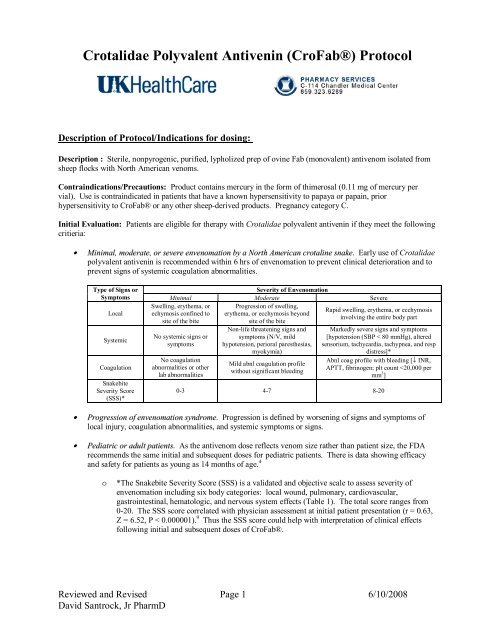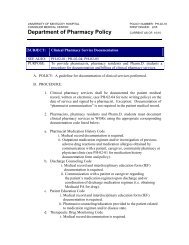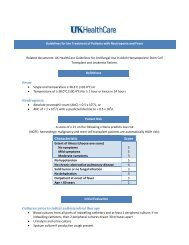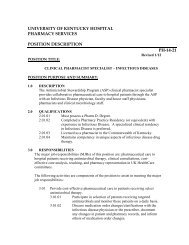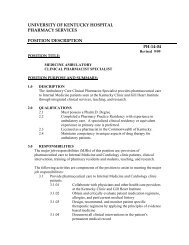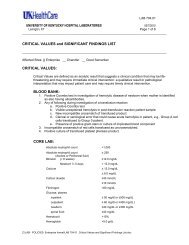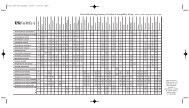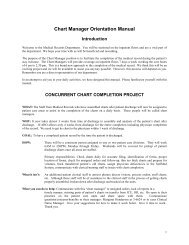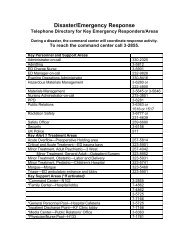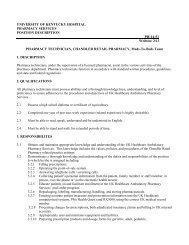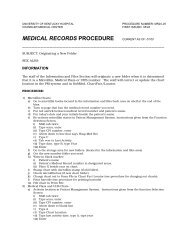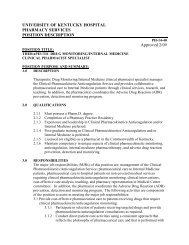Crotalidae Polyvalent Antivenin (CroFab®) Protocol
Crotalidae Polyvalent Antivenin (CroFab®) Protocol
Crotalidae Polyvalent Antivenin (CroFab®) Protocol
You also want an ePaper? Increase the reach of your titles
YUMPU automatically turns print PDFs into web optimized ePapers that Google loves.
<strong>Crotalidae</strong> <strong>Polyvalent</strong> <strong>Antivenin</strong> (CroFab®) <strong>Protocol</strong>Description of <strong>Protocol</strong>/Indications for dosing:Description : Sterile, nonpyrogenic, purified, lypholized prep of ovine Fab (monovalent) antivenom isolated fromsheep flocks with North American venoms.Contraindications/Precautions: Product contains mercury in the form of thimerosal (0.11 mg of mercury pervial). Use is contraindicated in patients that have a known hypersensitivity to papaya or papain, priorhypersensitivity to CroFab® or any other sheep-derived products. Pregnancy category C.Initial Evaluation: Patients are eligible for therapy with <strong>Crotalidae</strong> polyvalent antivenin if they meet the followingcritieria:• Minimal, moderate, or severe envenomation by a North American crotaline snake. Early use of <strong>Crotalidae</strong>polyvalent antivenin is recommended within 6 hrs of envenomation to prevent clinical deterioration and toprevent signs of systemic coagulation abnormalities.Type of Signs orSeverity of EnvenomationSymptoms Minimal Moderate SevereLocalSwelling, erythema, or Progression of swelling,Rapid swelling, erythema, or ecchymosisechymosis confined to erythema, or ecchymosis beyondinvolving the entire body partsite of the bitesite of the biteSystemicCoagulationSnakebiteSeverity Score(SSS)*No systemic signs orsymptomsNo coagulationabnormalities or otherlab abnormalitiesNon-life threatening signs andsymptoms (N/V, mildhypotension, perioral paresthesias,myokymia)Mild abnl coagulation profilewithout significant bleedingMarkedly severe signs and symptoms[hypotension (SBP < 80 mmHg), alteredsensorium, tachycardia, tachypnea, and respdistress]*Abnl coag profile with bleeding [↓ INR,APTT, fibrinogen; plt count
Treatment AlgorithmMinimal EnvenomationModerate EnvenomationSevere EnvenomationObserve patient for signs andsymptoms of progression ofenvenomation syndrome.Initial CroFab dose of 4grams (see Preparation below)Initial Response/ControlInitial Dose of 4 grams (seePreparation below)Initial Response/ControlProgression of envenomationYesNoNoRepeat 4-6gm dose in 250mlSodium Chloride USPNoYesMonitor for signs & symptoms ofprogression of envenomationsyndromeYesNo antivenintreatment necessaryEnvenomation Progression?Maintenance Dosing: 2gm q6h x3 doses at 6h, 12h, 18h post loadNoYesNo further treatment necessaryaInitial response or control: Initial control is cessation of progression of local effects, systemic effects, and coagulopathy from envemonation.Patients should be monitored up to one hour following FabAV dosing to assess initial response/control.Clinical response: Pre-treatment signs and symptoms of envenomation were arrested or improved after treatment.Partial response: Signs and symptoms of envenomation worsened, but at a slower rate than expected after treatment.Non-response: Patient’s condition was not favorably affected by treatment.bPatients with documented rattlesnake envenomations should be evaluated for scheduled maintenance dosing to prevent recurrence ofenvenomation.Preparation/Administration:• Preparation: If possible, the initial 4-6 gram dose should be prepared in 2 gram increments administeredwith approximately 100 ml of 0.9% Sodium Chloride, USP. Fluid adjustments may be needed for patient 12YOA. 8Subsequent administration of CroFab® doses:• Following an initial response, additional doses of CroFab® have been suggested at doses of 2 grams q 6hrsx 3 doses (18 hrs) to limit the chance of recurrence of envenomation. Dart and colleagues noted asignificant risk of recurrence in 8/16 patients (50%) (P = 0.002) when given PRN doses of CroFab®compared with scheduled maintenance doses following an initial response. 2 However, Ruha et.al. noted that6/28 pts (21%) had a hematologic recurrence with the scheduled maintenance doses. 3 Thus all patientstreated with CroFab® may be at risk of a recurrence as evident by bleeding, thrombocytopenia, andcoagulopathy.Reviewed and Revised Page 2 6/10/2008David Santrock, Jr PharmD
Appendix/References:Table 1: Snakebite Severity Score. Adapted from reference 9.Snakebite Severity Score (SSS) 9CriterionPointsPulmonary SymptomsNo symptoms/signs 0Dyspnea, minimal chest tightness, mild or vague discomfort, or respirations of 20-25 breaths/minute 1Moderate respiratory distress [tachypnea, 26-40 breaths/minute; accessory muscle use] 2Cyanosis, air hunger, extreme tachypnea, or respiratory insufficiency/failure 3Cardiovascular systemNo symptoms/signs 0Tachycardia [100-125 BPM], palpitations, generalized weakness, benign dysrythmia, or hypotension 1Tachycardia [126-175 BPM] or hypotension, with SBP > 100 mmHg 2Extreme tachycardia [>175 BPM], hypotension with SBP < 100 mmHg, malignant dysrythmia, or cardiac 3arrestLocal woundNo symptoms/signs 0Pain, swelling, or ecchymosis within 5-7.5cm of bite site 1Pain, swelling or ecchymosis involving less than half the extremity [7.5-50cm from bite site] 2Pain, swelling or ecchymosis involving half to all of extremity [50-100cm from bite site] 3Pain, swelling or ecchymosis extending beyond affected extremity [more than 100cm from bite site] 4Gastrointestinal systemNo symptoms/signs 0Pain, tenesmus, or nausea 1Vomiting or diarrhea 2Repeated vomiting, diarrhea, hematemesis, or hematocheszia 3Hematologic symptomsNo symptoms/signs 0Coagulation parameters slightly abnormal: PT < 20 secs; PTT


